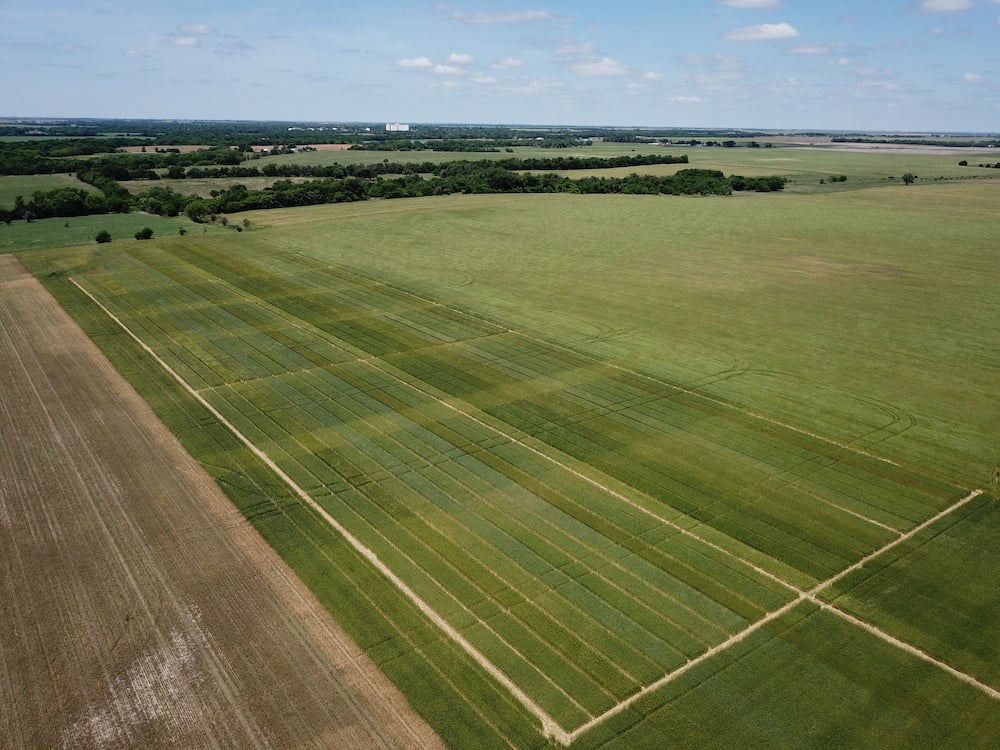In a challenging market, some crop consultants don’t have the time or interest for research or experimentation. But for Tyler Knight, owner of TANA Ag Solutions Group, test plots yield much more than wheat.
“Test sites are a good learning tool for growers, allowing them to see some management practices that they aren’t comfortable with—and to see it in a controlled environment,” Tyler says. The results of test plots provide farmers with information they can use on their own operations, while allowing Tyler to showcase TANA’s precision management program and refine his nutrient recommendations.
It’s the third year TANA has hosted the Cooperative Learning Site near Renfrow, Oklahoma. Top objectives were to examine how varying nitrogen application rates affect grain protein content, test weight, yield per acre, and baking and milling characteristics.
An initial mix of hard red and hard white winter wheat planted mid-October 2019 included 24 varieties, representing seven different seed companies. During the growth of the wheat plot, Ceres Imaging flew over the crop three times to capture aerial data.
“The critical piece to this process is timeliness and the reliable capture of the imagery,” Tyler says. “The technical support from the Ceres Imaging support staff and agronomist, John West, is vital to making this test plot a success.”

A view of crop consultant Tyler Knight's test plot near Renfrow, Oklahoma.
A key output from TANA’s test plot is more precise fertilizer prescriptions—developed using rigorously quality-controlled NDVI data from Ceres Imaging.
“We utilize aerial imagery to pull the NDVI values out and derive a nitrogen recommendation,” Tyler explains. “The nitrogen recommendations usually can help growers gain around 8-10 bushels an acre and a higher protein content in the crop.”
Ceres Imaging agronomist John West says growers generally make wheat nitrogen topdress applications in late January through February. However, research now suggests that they can make nitrogen applications as late as the hollow stem growth stage and maintain yields—if not improve them.
With TANA’s N-Check topdress program, producers can wait until the crop breaks winter dormancy and greens up before applying. Aerial data captured at the point can be used to predict yields and create a zone map for a variable rate nitrogen prescription. That level of accuracy used to require Tyler to visit each field individually to take NDVI readings with a handheld Greenseeker. Now, Ceres Imaging does the legwork—leaving Tyler with more time to focus on designing the best possible prescriptions for his customers.

Aerial data helps researchers evaluate crop health under different test conditions.
With Ceres Imaging delivering data from the air, a range of other partners support the test plots on the ground. Cooperating growers Tim Turek of Turek Seed Wheat and Greg Turek of Turek Seed Co. provided equipment, labor, and a portion of the seed for the test. Other seed companies—including Kansas Wheat Alliance, Oklahoma Genetics, Inc., PlainsGold, and Agrimaxx—donated the remainder of the seed varieties.
Dr. Brian Arnall, precision nutrient management extension specialist from Oklahoma State University, provided the harvesting and final data, baking and milling analysis on the wheat. Graduate students from the department were also part of the processing, analysis, and harvest crew.
The broad range of partners involved in the test site—from academics and Ceres Imaging data scientists to growers and seed dealers—serves TANA’s goal of arming customers with the most actionable and up-to-date information available. The work doesn’t stop with the wheat harvest: as of early July the plot has been put into double crop soybean, with results expected to guide Tyler’s prescriptions for the season ahead.
